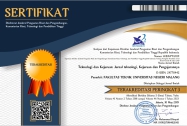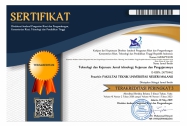Integrating STEM into the Formal and Instructional Curriculum to Support Machine Construction Design
Abstract
Keywords
Full Text:
PDFReferences
Anggraini, FI, & Huzaifah, S. (2017). Implementation of STEM in science learning in junior high schools. Biology Education Study Program, Faculty of Teacher Training and Education, Sriwijaya University, 1998, 722–731.
Barakos, L., Lujan, V., & Strang, C. (2012). Science, technology, engineering, and mathematics (STEM): Catalyzing change amid the confusion. Mathematics (Stem), 1–28. http://files.eric.ed.gov/fulltext/ED534119.pdf
Brown, R., Brown, J., Reardon, K., & Merrill, C. (2011). Understanding STEM: Current perceptions. Publications, 70(6), 5–9.
Chen, M. (2001). A Potential Limitation of Embedded-Teaching for Formal Learning. Proceedings of the Annual Meeting of the Cognitive Science Society, 23(23), 276–281.
Concepts, C. (2011). Engineering Practices. December.
Ejiwale, JA (2013). Barriers To Successful Implementation of STEM Education. Journal of Education and Learning (EduLearn), 7(2). https://doi.org/10.11591/edulearn.v7i2.220
Firman, H. (2015). STEM-Based Science Education: Concepts, Development, and Role of Postgraduate Research. National Seminar on Science and PKLH Education, 151, 10–17. https://www.academia.edu/21597075/EDUCATION_SAINS_BERBASIS_STEM_KONSEP_PENGEMBANGAN_DAN_PERANAN_RISET_PASCASARJANA
Khoiriyah, N., Abdurrahman, A., & Wahyudi, I. (2018). Implementation of the STEM learning approach to improve the critical thinking skills of high school students on sound wave material. Journal of Physical Education Research and Studies, 5(2), 53–62. https://doi.org/10.12928/jrkpf.v5i2.9977
Kurniawan, AAN, Sudjimat, DA, & Nurhadi, D. (2019). Characteristics of STEM in Mechanical Construction Designers by Mechanical Engineering Education Students at the State University of Malang. Journal of Technology, Vocational, And Teaching, 42(2), 96–106.
Miles, MB, & Huberman, AM (1994). Qualitative Data Analysis: A Methods Sourcebook. Arizona: Arizona State University.
National STEM Education Center. 2014. STEM Education Network Manual. Bangkok: The Institute for the Promotion of Teaching Science and Technology.
Reeve, EM (2013). Implementing Science , Technology , Mathematics , and Engineering ( STEM ) Education in Thailand and in ASEAN A Report Prepared for : Prepared by : 1–22.
Roberts, A. (2012). A Justification for STEM Education. Technology and Engineering Teachere, May/June(June), 1–5. http://botbrain.com/index.
Rustaman, NY (2016). Future Science Learning Based on STEM Education. In Proceedings of the National Seminar on Educational Biology (April Issue). http://semnasbioedu.stkip-pgri-sumbar.ac.id/wp-content/uploads/2017/02/prosiding-semnas-bioedu-1-finale1.pdf
Stohlmann, M., Moore, T., & Roehrig, G. (2012). Considerations for Teaching Integrated STEM Education. Journal of Pre-College Engineering Education Research, 2(1), 28–34. https://doi.org/10.5703/1288284314653
Sulaiman, S. (2013). Modern Patterns of Organizational Curriculum Development. Scientific Journal of Didactics, 14(1), 60–73. https://doi.org/10.22373/jid.v14i1.489
Wang, H., Moore, TJ, Roehrig, GH, & Park, MS (2011). STEM Integration : Teacher Perceptions and Practice STEM Integration : Teacher Perceptions and Practice. Journal of Pre-College Engineering Education Research (J-PEER), 1(2), 1–13. https://doi.org/10.5703/1288284314636
Winarni, J., Zubaidah, S., & H, SK (2016). STEM: what, why, and how. In Proceedings of the UM Postgraduate Science Education National Seminar (Vol. 1, pp. 976–984).
DOI: http://dx.doi.org/10.17977/um031v44i22021p100-107
Refbacks
- There are currently no refbacks.
Copyright (c) 2022 Teknologi dan Kejuruan: Jurnal Teknologi, Kejuruan, dan Pengajarannya
Teknologi dan Kejuruan: Jurnal Teknologi, Kejuruan, dan Pengajarannya
E-ISSN 2477-0442 (online)
Contact
Faculty of Engineering, Universitas Negeri Malang (UM)
Jl. Semarang No 5 Malang 65145, Building H5, 1st Floor.
Homepage: http://journal2.um.ac.id/index.php/teknologi-kejuruan
Email: teknologikejuruan.ft@um.ac.id

This work is licensed under a Creative Commons Attribution 4.0 International License.



2.png)
1.png)
1.png)
1.png)
4.png)
1.png)
.png)

3.png)
1.png)
1.png)


